BEC高级口语思维导图.png
- 格式:pdf
- 大小:7.31 MB
- 文档页数:1
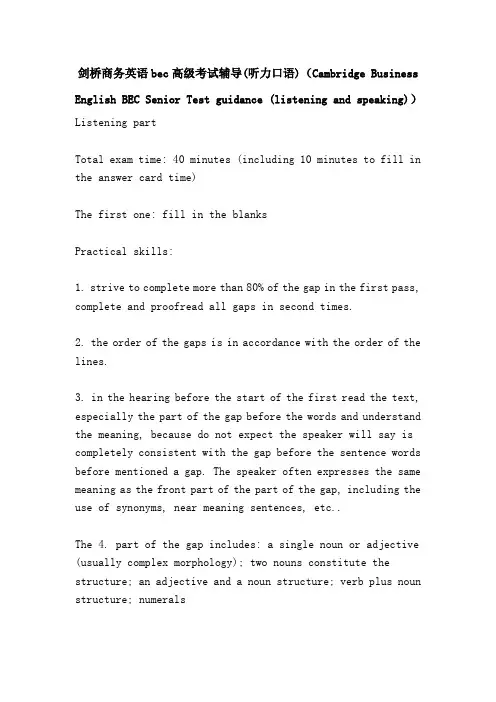
剑桥商务英语bec高级考试辅导(听力口语)(Cambridge Business English BEC Senior Test guidance (listening and speaking))Listening partTotal exam time: 40 minutes (including 10 minutes to fill in the answer card time)The first one: fill in the blanksPractical skills:1. strive to complete more than 80% of the gap in the first pass, complete and proofread all gaps in second times.2. the order of the gaps is in accordance with the order of the lines.3. in the hearing before the start of the first read the text, especially the part of the gap before the words and understand the meaning, because do not expect the speaker will say is completely consistent with the gap before the sentence words before mentioned a gap. The speaker often expresses the same meaning as the front part of the part of the gap, including the use of synonyms, near meaning sentences, etc..The 4. part of the gap includes: a single noun or adjective (usually complex morphology); two nouns constitute the structure; an adjective and a noun structure; verb plus noun structure; numeralsThe 5. gap is the noun (or noun structure) of the sign: the emergence of prepositions before the gap.The 6. gap is the mark of adjectives: there are nouns after the gap.The 7. gap is the sign of the verb (or verb structure): there is a preposition after the gap.The 8. gap is the sign of numeral (or numeral structure): the emergence of number, percentage and other prompt words before and after the gap.9. when the word (or structure) is too long at the gap, you can take shorthand at the first time, and finish it second times.10. when you really grasp the Chinese meaning of the word in the gap, but can not think of English, you can use synonyms instead.Second: the number of matching (to make thousands of candidates in the examination room, hardly wished to live.!!)Practical skills:1. grasp the Chinese meaning of each option, and imagine the words that the speaker may use whenever the choice is expressed or described.2., if you hear the content of the article is consistent with an option, generally bold to exclude this option.3. the expression in the correct option is synonymous with some part of the text. (part of the content or just a word or phrase; or a sentence)4. pay attention to the speaker's tone. (this method is especially applicable to the judgment of speaker's attitudes)5. candidates usually need to know more about the language use of various commercial occasions.The third item: multiple choicePractical skills:1. all questions are asked according to the order of the text.2. for each problem, the speaker has a clear and prompt exposition, so the key to solving problems is to find and understand these tips.The use of 3. suggestive words. The prompt words used by general speakers are: but; but I think; real... Fact is that... ;... Not the case; it is... Which/that... ;4. some words are synonymous with the words in the answer.5. let the reader infer the answer by giving an example.6. put the answer ahead of the examples.7., the speaker's confusion of the listener includes:(1) put forward some so-called reasons at the beginning, and put the real reason at the end.(2) the speaker will listen to some "prompt" at a quicker rate, usually some phrasal phrases, to confuse listeners. The words in the "prompt" often appear directly in the options.8., combined with the above points, it is not difficult to find the correct answer in this item are indirect given, usually through the speaker's 2 to 3 steps.Oral partThe whole exam time is about 16 minutes.The first one: ask for personal informationThe exam time: about 3 minutes.The form of the examination: the examiner puts questions to the examinee one by one, and the examinee answers.This examination content: involves many aspects of personal information, examiner questioning is ever-changing, but must design some aspects of personal information. Usually, in order to check the qualification of candidates,考官会问以下问题:你叫什么名字?/你能拼一下你的姓吗?/你能拼一下你的姓吗?/你的电话号码是多少?回答范例:我的名字是瑞。

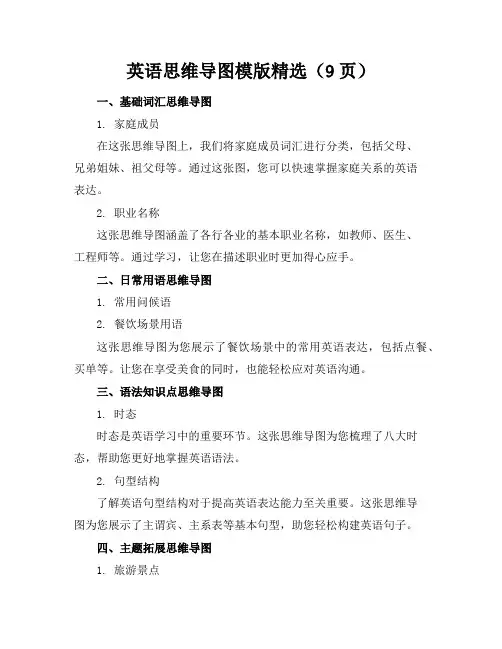
英语思维导图模版精选(9页)一、基础词汇思维导图1. 家庭成员在这张思维导图上,我们将家庭成员词汇进行分类,包括父母、兄弟姐妹、祖父母等。
通过这张图,您可以快速掌握家庭关系的英语表达。
2. 职业名称这张思维导图涵盖了各行各业的基本职业名称,如教师、医生、工程师等。
通过学习,让您在描述职业时更加得心应手。
二、日常用语思维导图1. 常用问候语2. 餐饮场景用语这张思维导图为您展示了餐饮场景中的常用英语表达,包括点餐、买单等。
让您在享受美食的同时,也能轻松应对英语沟通。
三、语法知识点思维导图1. 时态时态是英语学习中的重要环节。
这张思维导图为您梳理了八大时态,帮助您更好地掌握英语语法。
2. 句型结构了解英语句型结构对于提高英语表达能力至关重要。
这张思维导图为您展示了主谓宾、主系表等基本句型,助您轻松构建英语句子。
四、主题拓展思维导图1. 旅游景点这张思维导图为您介绍了世界各地的旅游景点,包括自然风光、人文景观等。
让您在规划旅行时,也能学到实用的英语表达。
2. 节日习俗了解各国节日习俗,有助于拓宽国际视野。
这张思维导图为您展示了中西节日的庆祝方式,让您在跨文化交流中更加得体。
五、提升听说能力思维导图1. 英语听力场景为了帮助您提高英语听力,这张思维导图精选了多种听力场景,如机场、电影院、超市等。
通过针对性的场景练习,让您在实际交流中更加游刃有余。
2. 口语表达技巧提升口语能力,不仅需要积累词汇,还要掌握表达技巧。
这张思维导图为您提供了各种口语表达技巧,如连读、弱读、语调等,让您的英语口语更加地道。
六、阅读理解思维导图1. 阅读策略提高阅读理解能力,策略至关重要。
这张思维导图为您介绍了略读、寻读、精读等阅读策略,帮助您更高效地阅读英语文章。
2. 文章结构解析了解文章结构对于把握文章大意至关重要。
这张思维导图为您分析了英语文章的常见结构,如引言、、结论等,让您在阅读时能更快地捕捉关键信息。
七、写作技巧思维导图1. 写作框架搭建写作时,一个清晰的框架能让您的文章更有条理。
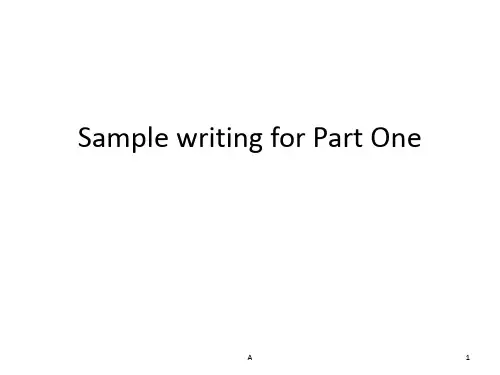
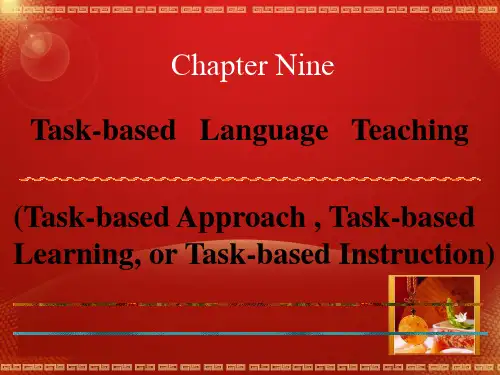
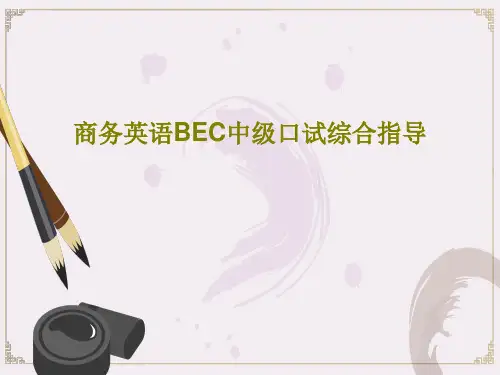
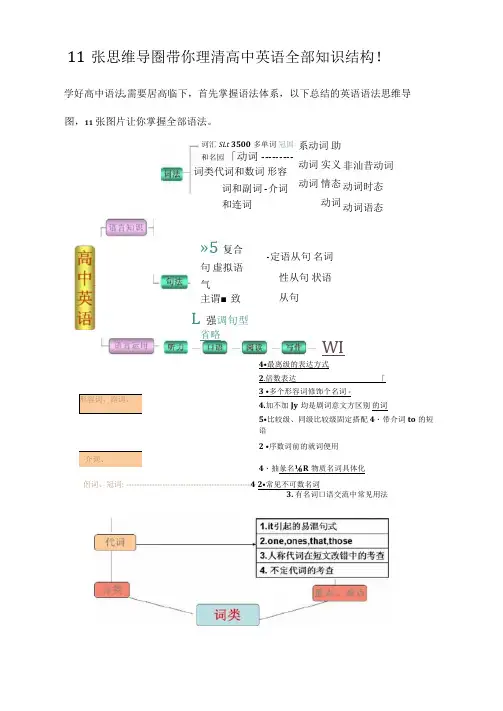
4•最离级的表达方式 2.倍数表达「3 •多个形容词修饰个名词 -4.加不加Jy 均是剧词意文方区别 的词5•比较级、同级比较级固定搭配 4・带介词to 的短语2 •序数词前的就词便用11张思维导圏带你理清高中英语全部知识结构!学好高中语法,需要居高临下,首先掌握语法体系,以下总结的英语语法思维导 图,11张图片让你掌握全部语法。
诃汇SLt 3500多单诃 冠国和名园 「动词 --------- 词类代词和数词 形容词和副词 -介词和连词 系动词 助动词 实义动词 情态动词 非汕昔动词 动词时态 动词语态 »5 复合句 虚拟语气主谓■致L强调旬型省略-定语从句 名词性从句 状语从句WI4・抽彖名⅛R 物质名词具体化侶词、冠词: ------------------------------------------------ 4 2•常见不可数名词3. 有名词口语交流中常见用法形容词、副词、介词、动词时态动词语态虚拟吾气]情杰动词非谓语动词—般式被动式进行式完成式to do (not) to do (not) to be done (not) to be doing (not) to have doneV-Ing(not) doing (not) being done (not) having done done (not) done主语宾语状语定语补足语农语插入语to do**to make matters worse, toPUt it mildly, to toll thetruth, generally SPeaking,COnSidering, allowing for,judging fromV-ing **done **1非谓语动词作状语与独立主格结构、状语从句的区分。
__________________________________ 2非谓语动词作定语。
3 With复合结构和as引导的状语从句的区别。


